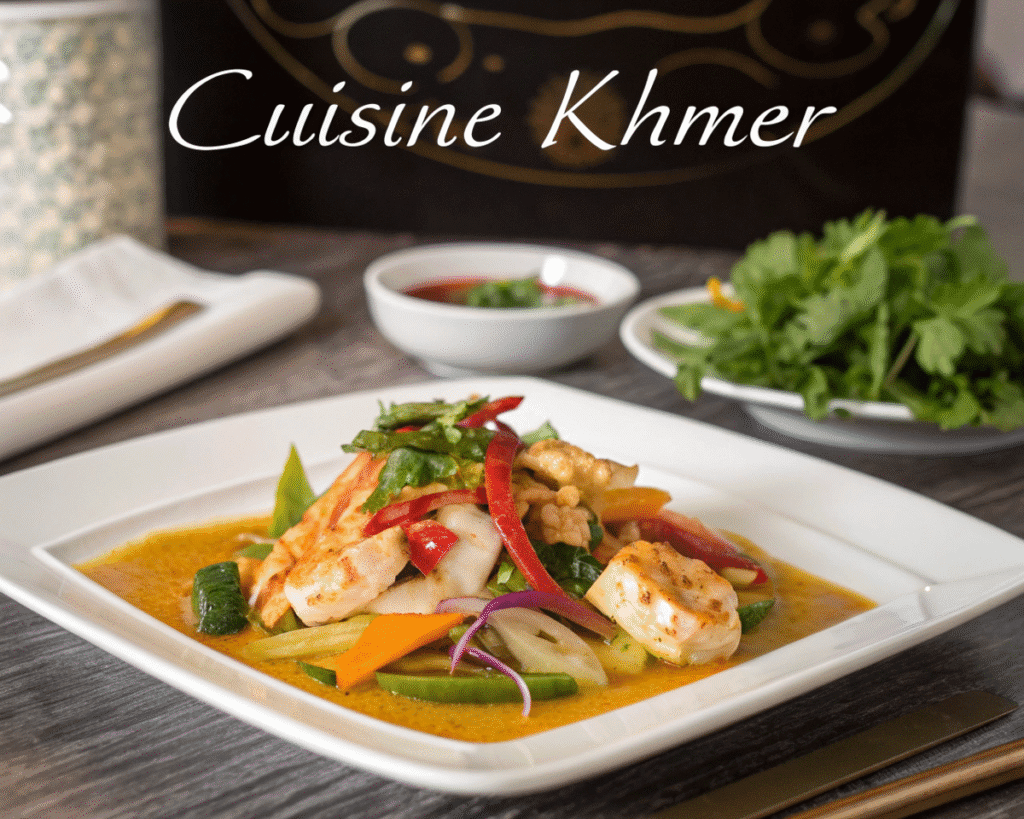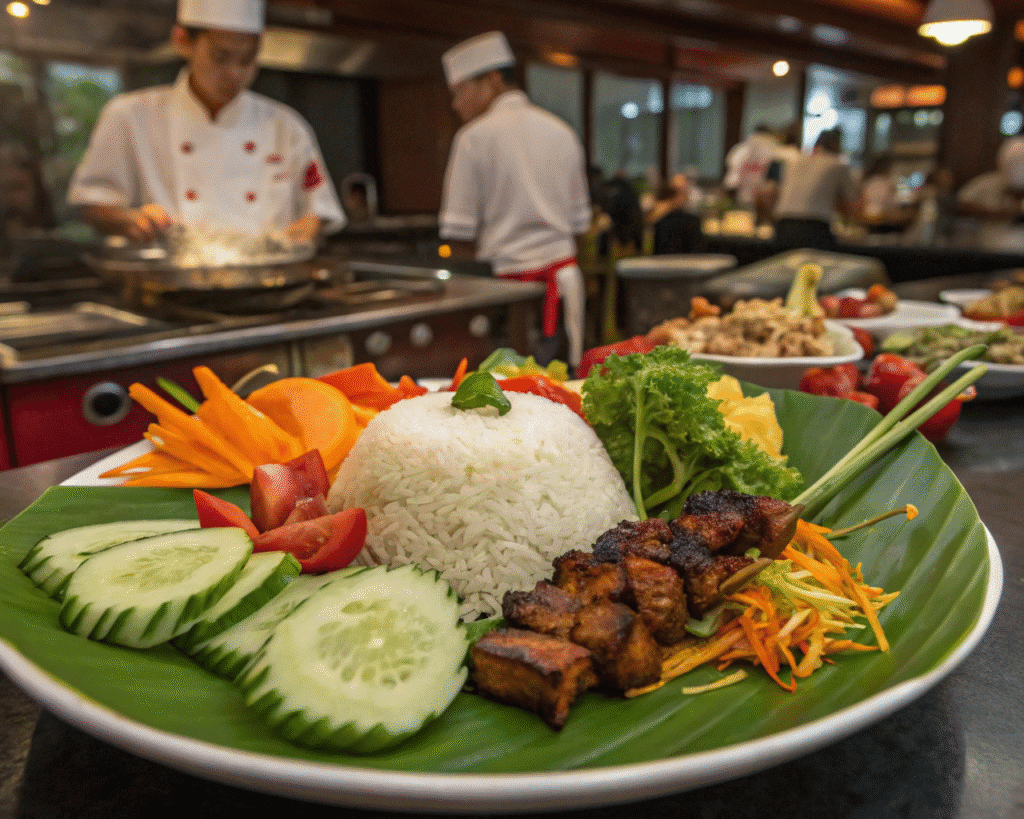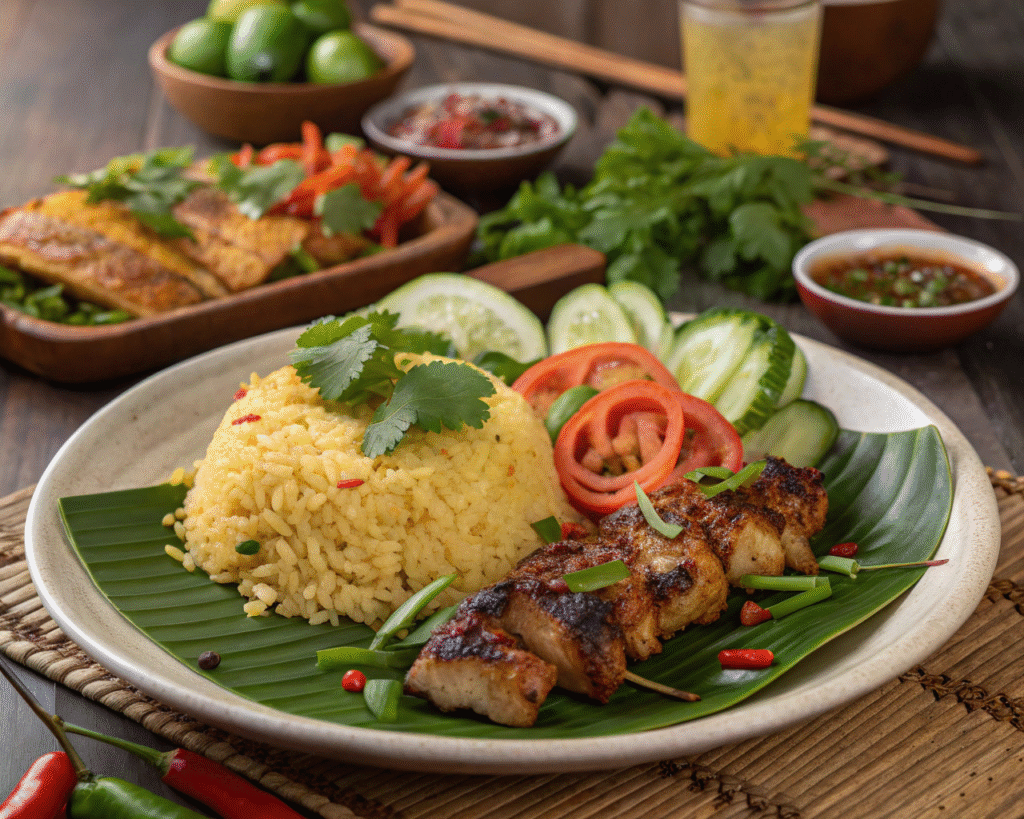Cuisine Khmer, the traditional culinary art of Cambodia, is a vibrant tapestry of flavors, history, and culture that has captivated food enthusiasts worldwide. Rooted in the ancient Khmer Empire and shaped by centuries of regional influences, this cuisine offers a unique blend of sweet, sour, salty, and spicy notes. From the iconic fish amok to the hearty samlor korkor, Khmer dishes are a testament to Cambodia’s rich agricultural landscape and culinary ingenuity. In this comprehensive guide, we’ll delve into the origins of cuisine Khmer, explore its preparation methods, highlight its nutritional benefits, and provide practical tips for creating authentic Khmer dishes at home. Whether you’re a foodie, a home cook, or simply curious about Cambodian culture, this article will inspire you to discover the essence of Khmer cuisine.
The Origins of Cuisine Khmer: A Historical Journey

A Legacy of the Khmer Empire
Cuisine Khmer traces its roots back to the Khmer Empire (802–1431 AD), a powerful civilization that once spanned modern-day Cambodia, Thailand, Laos, and southern Vietnam. The empire’s culinary traditions were shaped by its fertile lands, abundant waterways, and interactions with neighboring cultures. The Mekong River, Tonlé Sap Lake, and Bassac River provided a steady supply of freshwater fish, a cornerstone of Khmer cuisine, while rice paddies yielded the staple grain that remains central to every meal. The Khmer term for “to eat” is nam bai, literally “eat rice,” underscoring its cultural significance.
The Bayon temple, built in the 12th–13th century, offers a glimpse into ancient Khmer kitchens through its bas-reliefs, depicting utensils like earthenware pots, coconut shell ladles, and leaf-based containers still used today. These tools highlight the resourcefulness of Khmer cooks, who crafted sophisticated dishes with simple materials. The royal kitchens of the Khmer Empire produced refined dishes, such as amok trei (steamed fish curry), which continue to define Khmer royal cuisine.
Cultural Influences on Cuisine Khmer
Khmer cuisine is a melting pot of influences from India, China, Thailand, Vietnam, and France, yet it retains a distinct identity. Indian traders introduced curry pastes and spices like turmeric and cardamom as early as 2,000 years ago, evident in dishes like saraman curry. Chinese immigrants brought stir-frying techniques and noodle dishes, such as kuy teav (rice noodle soup). Thai and Vietnamese influences are seen in shared ingredients like lemongrass and galangal, though Khmer cuisine is generally less spicy and sweeter. French colonial rule (1863–1953) introduced baguettes and pâté, leading to Khmer-style sandwiches akin to Vietnamese banh mi.
The Khmer Rouge regime (1975–1979) nearly erased these traditions by restricting cooking and farming, leading to widespread starvation. Post-regime, chefs like Ros Rotanak (Chef Nak) and Kimsan Pol have worked tirelessly to revive Khmer recipes, with cookbooks like Saoy and The Culinary Art of Cambodia preserving dishes like samlor muktaa (white pearl soup).

Key Ingredients in Cuisine Khmer
Cuisine Khmer is defined by its fresh, local ingredients and bold flavor profiles. Here are the essentials:
- Rice: The backbone of Khmer meals, with varieties like jasmine, sticky, and malis rice (award-winning at the World Rice Conference).
- Fish: Freshwater fish like catfish, snakehead, and goby dominate, often used in soups, curries, and fermented pastes.
- Prahok: A fermented fish paste, prahok is the hallmark of Khmer cuisine, adding umami depth to dishes like prahok k’tis (a creamy dip).
- Kroeung: A spice paste made from lemongrass, galangal, turmeric, kaffir lime leaves, garlic, and shallots, used in curries and soups.
- Herbs and Spices: Fresh herbs like basil, mint, cilantro, and sawleaf coriander, alongside spices like Kampot pepper and tamarind, create complex flavors.
- Vegetables and Fruits: Common vegetables include winter melon, bok choy, and banana flowers, while fruits like mango, durian, and jackfruit feature in salads and desserts.
- Fermented Sauces: Fish sauce, oyster sauce, and soy sauce are staples, often paired with lime juice, chili, and palm sugar for dipping sauces.
These ingredients reflect Cambodia’s agricultural abundance and the Khmer emphasis on balancing sweet, sour, salty, and spicy flavors.
Nutritional Values of Cuisine Khmer
A Balanced Diet Rooted in Tradition
Cuisine Khmer is not only flavorful but also nutritionally rich, though challenges like malnutrition persist in Cambodia due to economic disparities. Here’s a breakdown of its nutritional profile:
- High in Protein: Freshwater fish, a primary protein source, provides lean protein and omega-3 fatty acids, supporting heart health and muscle growth. Dishes like fish amok and khor trey (caramelized fish soup) are protein-rich.
- Rich in Fiber and Vitamins: Vegetables like cabbage, spinach, and banana flowers, along with fruits like papaya and mango, supply dietary fiber, vitamins A and C, and antioxidants, aiding digestion and immunity.
- Low in Fat: Unlike Western cuisines, Khmer dishes use minimal oil, relying on steaming, boiling, or grilling. Coconut milk adds healthy fats in moderation, as seen in amok and kari sach moan (chicken red curry).
- Carbohydrate Source: Rice provides energy through complex carbohydrates, though excessive reliance on white rice can limit dietary diversity. Sticky rice, used in desserts, offers a slower energy release.
- Fermented Foods: Prahok and other fermented ingredients like mam (fermented seafood) contain probiotics, promoting gut health.
Nutritional Challenges
Despite its potential, Cambodia faces high rates of malnutrition, particularly among children and pregnant women, due to limited access to diverse foods like meat and vegetables, which are considered luxuries. Studies show that Khmer diets often lack sufficient protein and micronutrients like iron and zinc, contributing to anemia and stunting. Efforts to increase food diversity, such as incorporating more vegetables and protein sources in daily meals, are underway to address these issues.
How to Prepare Cuisine Khmer: Recipes and Techniques
Essential Cooking Techniques
Khmer cuisine emphasizes simplicity and freshness, with techniques that enhance natural flavors:
- Steaming: Used in fish amok, steaming in banana leaves preserves nutrients and imparts a delicate texture.
- Boiling: Soups like samlor korkor and chrok krao chhnang are boiled to create flavorful broths.
- Grilling: Dishes like bai sach chrouk (pork and rice) and trey aing (grilled fish) use grilling for smoky flavors.
- Fermentation: Prahok and mam are fermented for months, adding depth to dishes.
- Stir-Frying: Influenced by Chinese cuisine, stir-frying is used in dishes like mee katang (wide rice noodle stir-fry).
Recipe 1: Fish Amok (Amok Trei)
Fish amok is Cambodia’s national dish, a creamy curry steamed in banana leaves. Here’s how to make it at home:
Ingredients (Serves 4):
- 400g freshwater fish (catfish or goby), skinned and sliced
- 2 tbsp yellow kroeung (lemongrass, galangal, turmeric, kaffir lime zest, garlic, shallots)
- 200ml coconut milk
- 1 tbsp fish sauce
- 1 tsp palm sugar
- 1 egg, beaten
- 2 kaffir lime leaves, finely sliced
- 1 red chili, sliced
- Banana leaves for steaming
- Steamed jasmine rice, to serve

Instructions:
- Prepare Banana Leaves: Soften banana leaves by blanching in hot water. Cut into 20cm squares and form into cups, securing with toothpicks.
- Make Curry Paste: Blend kroeung ingredients into a smooth paste.
- Mix Curry Base: In a bowl, combine fish, kroeung, coconut milk, fish sauce, palm sugar, and egg. Stir until well-coated.
- Fill Banana Cups: Spoon the mixture into banana leaf cups, top with kaffir lime leaves and chili.
- Steam: Place cups in a steamer and cook for 20–25 minutes until set.
- Serve: Serve hot with jasmine rice, garnished with extra herbs.
Nutritional Benefits: High in protein (fish), healthy fats (coconut milk), and antioxidants (turmeric, lemongrass).
Recipe 2: Samlor Korkor
This hearty soup is a Cambodian staple, adaptable to seasonal ingredients.
Ingredients (Serves 4):
- 300g catfish or pork belly, cubed
- 2 tbsp prahok
- 2 tbsp kroeung
- 1 cup mixed vegetables (cabbage, winter melon, long beans)
- 1 tbsp toasted ground rice
- 1 tbsp fish sauce
- 1 tsp palm sugar
- 1.5L water
- Fresh herbs (basil, sawleaf coriander) for garnish
Instructions:
- Prepare Broth: In a pot, bring water to a boil. Add prahok and kroeung, stirring to dissolve.
- Cook Protein: Add fish or pork, simmering until tender (15–20 minutes).
- Add Vegetables: Stir in vegetables and cook for 5–7 minutes until softened.
- Thicken: Add toasted ground rice to thicken the broth, stirring well.
- Season: Add fish sauce and palm sugar, adjusting to taste.
- Serve: Garnish with fresh herbs and serve with rice.
Nutritional Benefits: Rich in protein, fiber (vegetables), and probiotics (prahok).
Recipe 3: Pleah Sach Ko (Khmer Beef Salad)
A refreshing, ceviche-style salad with bold flavors.
Ingredients (Serves 4):
- 300g beef, thinly sliced
- 1/4 cup lime juice
- 1 tbsp fish sauce
- 1 tsp sugar
- 1 shallot, thinly sliced
- 1 red chili, sliced
- 1/2 cup mixed herbs (mint, basil, cilantro)
- 1 tbsp roasted ground rice
- 1/4 cup crushed peanuts
Instructions:
- Marinate Beef: Toss beef with lime juice and let sit for 10 minutes to “cook.”
- Mix Dressing: Combine fish sauce, sugar, shallots, and chili.
- Assemble Salad: Toss beef with dressing, herbs, and roasted rice.
- Serve: Top with peanuts and serve chilled or warm.
Nutritional Benefits: High in protein, low in fat, and rich in vitamins from herbs.
Tips for Authentic Cuisine Khmer at Home
- Source Fresh Ingredients: Visit Asian markets for lemongrass, galangal, and kaffir lime leaves. Use fresh fish for authenticity.
- Master Kroeung: Blend kroeung fresh for the best flavor. Store extras in the fridge for up to a week.
- Balance Flavors: Adjust fish sauce (salty), palm sugar (sweet), lime juice (sour), and chili (spicy) to taste.
- Use Banana Leaves: For steaming dishes like amok, banana leaves add aroma and authenticity.
- Experiment with Fermentation: Try making prahok at home by fermenting fish with salt for a month, though store-bought versions are widely available.
Where to Experience Cuisine Khmer
In Cambodia
- Phnom Penh: Visit Sombok or Embassy Restaurant for refined Khmer cuisine by Chef Kimsan Pol. Street food stalls (haan bai) offer affordable dishes like bai sach chrouk.
- Siem Reap: Try Kraya Angkor by Ly San for traditional recipes or join a cooking class at a local sala.
- Battambang: Recognized by UNESCO as a Creative City of Gastronomy, Battambang offers vibrant markets and restaurants showcasing local dishes.
Abroad
Khmer restaurants are rare outside Cambodia, but diaspora communities in cities like Seattle, Long Beach, and Paris serve authentic dishes. Look for restaurants offering fish amok, kuy teav, or nom banh chok. Online retailers like Angkor Food sell prahok and kroeung for home cooking.
Embracing Cuisine Khmer
Cuisine Khmer is a celebration of Cambodia’s history, resilience, and natural bounty. From its ancient roots in the Khmer Empire to its modern revival by passionate chefs, this cuisine offers a unique blend of flavors and nutrition. By mastering dishes like fish amok, samlor korkor, and pleah sach ko, you can bring the essence of Cambodia to your kitchen. Whether you’re savoring street food in Phnom Penh or experimenting with kroeung at home, cuisine Khmer invites you to explore a world of taste and tradition. Start your culinary journey today and discover why Khmer cuisine is gaining global recognition as a healthy, flavorful, and culturally rich cuisine.


